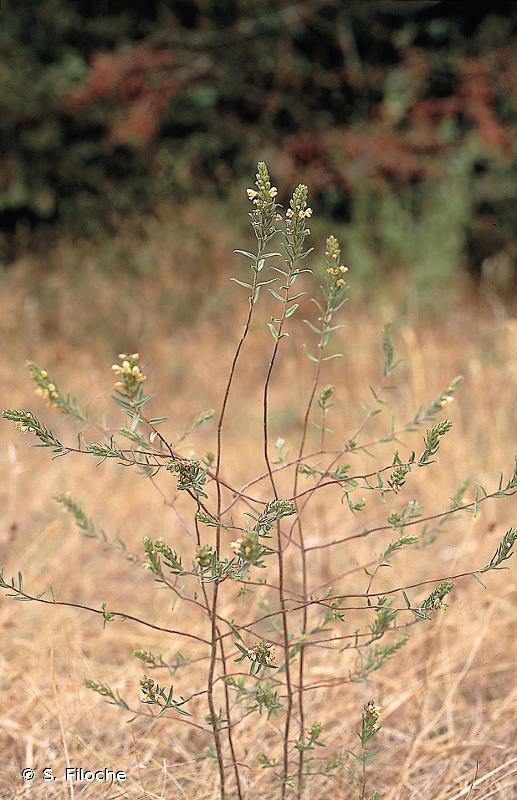
cd_nom

| Author : S. Filoche |
 |
To get the picture, please visit:
Sébastien Filoche,
CBNBP/MNHN
61, rue Buffon - 75005 Paris
email : inpn@mnhn.fr
Despite the Creative Commons license, please inform the author of the use which will be made of his photo

| Author : O. Nawrot |
 |
To get the picture, please visit:
Olivier Nawrot
email : inpn@mnhn.fr
Despite the Creative Commons license, please inform the author of the use which will be made of his photo
Taille
20 à 80 cm (hauteur).
Diagnose
Plante herbacée à tige dressée et non glanduleuse portant des feuilles lancéolées opposées. Inflorescences terminales allongées et unilatérales. Les fleurs sont jaune pâle ou jaune citrin. Leurs étamines ont des anthères qui ne se positionnement pas dans l'alignement des filets et qui forment un angle de 60-90 degrés avec eux. Les feuilles et les bractées inférieures sont normalement entières, rarement à 1 ou 2 dents.
Détermination
Moyennement difficile.
Espèces proches
Espèce d'aspect intermédiaire entre Odontites luteus et Odontites vernus. Odontites jaubertianus diffère d'Odontites vernus par ses fleurs jaunes (rose-pourprechez ce dernier). Odontites luteus possède des étamines à anthères alignées dans le prolongement des filets contrairement à Odontites jaubertianus (et aux autres Odontites) dont les anthères forment un angle net avec les filets.
Période d'observation
Floraison entre août et octobre
Biologie-éthologie
Espèce de thérophyte semi-parasite (herbacée annuelle) appartenant à la famille des Orobanchaceae. Cette famille modeste cosmopolite de 1500 espèces comporte nombres de parasites ou de semi-parasites. Odontites jaubertianus est une espèce hermaphrodite et entomogame.
Biogéographie et écologie
Espèce endémique Française : Sud du Bassin parisien, Centre-Ouest de l'Anjou au Périgord, Centre; très rare en Normandie et Champagne. Espèce localement peu commune à très rare, en régression.
Sources
Tison, J.-M., De Foucault, B. (coords). 2014. Flora Gallica - Flore de France, Ed. Biotope (Mèze), 1196p.
Simon Contant(Contant Simon - Botaniste Phytosociologue),2024
Continental
Metropolitan France
Overseas
Marine
Metropolitan France
Overseas
The map presents a summary at the 10 x 10 km grid of the observation data for the species transmitted to the SINP. These data have been subjected to validation filters.
The map presents a reference distribution layer of the species at the scale of departments and marine sectors. The presence and absence data were established by expertise within a network of partners. This reference distribution is used in the validation process of the SINP data at the INPN level.
Corresponds to a report on the basis of at least one observation proved within a period of 10 years (20 years for little-known invertebrates) preceding the year and no presumption of extinction since obtaining the last data nor doubt on reproductive and implemented nature of this population. For migratory species, the presence indicated concerns areas of reproduction.
This status is based on one or more of the following criteria:
This point covers the absence, more difficult by nature to demonstrate than presence. This status is based on one or more of the following criteria:
This status must be assigned to a department in which the presence of the species is casual.
Particular case of absence due to a proven extinction less than a half century ago (older disappearances are treated as "no probable or definite").
In the state of knowledge, we can not comment on the presence or absence in the current department. This is the default status when not comprised in one of the previous categories or whenever there is doubt.
The map shows the global distribution of the species based on GBIF data (Global Biodiversity Information Facility).
